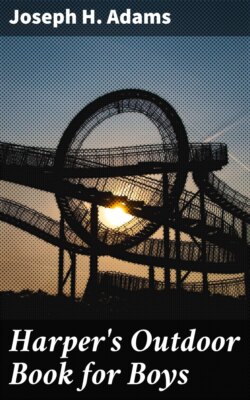Читать книгу Harper's Outdoor Book for Boys - Joseph H. Adams - Страница 14
На сайте Литреса книга снята с продажи.
Martin Boxes
ОглавлениеIn the early spring, when the birds return to the north, the martins are among the first to appear, and long before the swallows, whom they closely resemble, begin to nest they have hatched their young and have taken their departure from the southland.
They are cold-weather birds, fly rapidly, and do not stay long in one place. They seldom build their nests in the branches of trees, but prefer to find a hole in a tree-trunk, and there build a nest safe from the wind and storm. The sand-martin burrows a hole in the side of a bank, but never builds a nest in the chimneys as do his brother and sister swallows. The martin, when sitting on her eggs, likes a dark and sheltered place, and for that reason she takes kindly to a martin box in which a hole is made sufficiently large for her to fly in and out of.
In Fig. 1 a small keg is supported at the top of a post and braced at the bottom with two bracket pieces. A hole two inches and a half in diameter is made at each end of the keg, through which the martins can enter, and the post to which the keg is fastened is cut away at the upper end as shown in Fig. 2.
In one side of the bilge of the keg a hole is cut as large as the post is square or round, and at the other side a corresponding hole is cut the size of the upper part of the post. The keg is then dropped down over the post so that the shoulder, formed by cutting away the wood, will rest under the upper side of the keg, in which the smaller square hole has been cut.
If a round post is employed, the upper part should be cut square so as to prevent the wind from blowing the keg round the post. A cross-stick fastened at the top of the post will form a perch on which the birds may alight.
A box with a peaked roof and three divisions, intended to accommodate three families of the birds, is shown in Fig. 3.
An ordinary box may be cut and rearranged with a pitched roof, an inner floor, and the three divisions. A small hole is bored at each side of the box and a round stick passed through it, so that six or eight inches of the wood will project at either side to serve as perches. Another perch can be arranged at the top of the box, and this bird-house is then securely fastened to the upper end of a post and braced there with bracket-pieces nailed both to the bottom of the box and to the post.
The divisions in the box should be not less than six inches square and six or eight inches high. If the box used be square it will probably be an easier job to divide it into four divisions for as many families. Each compartment, of course, must be provided with its separate hole for ingress and egress.
